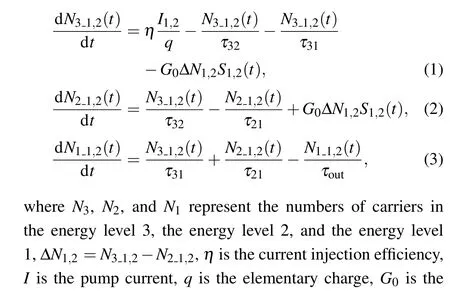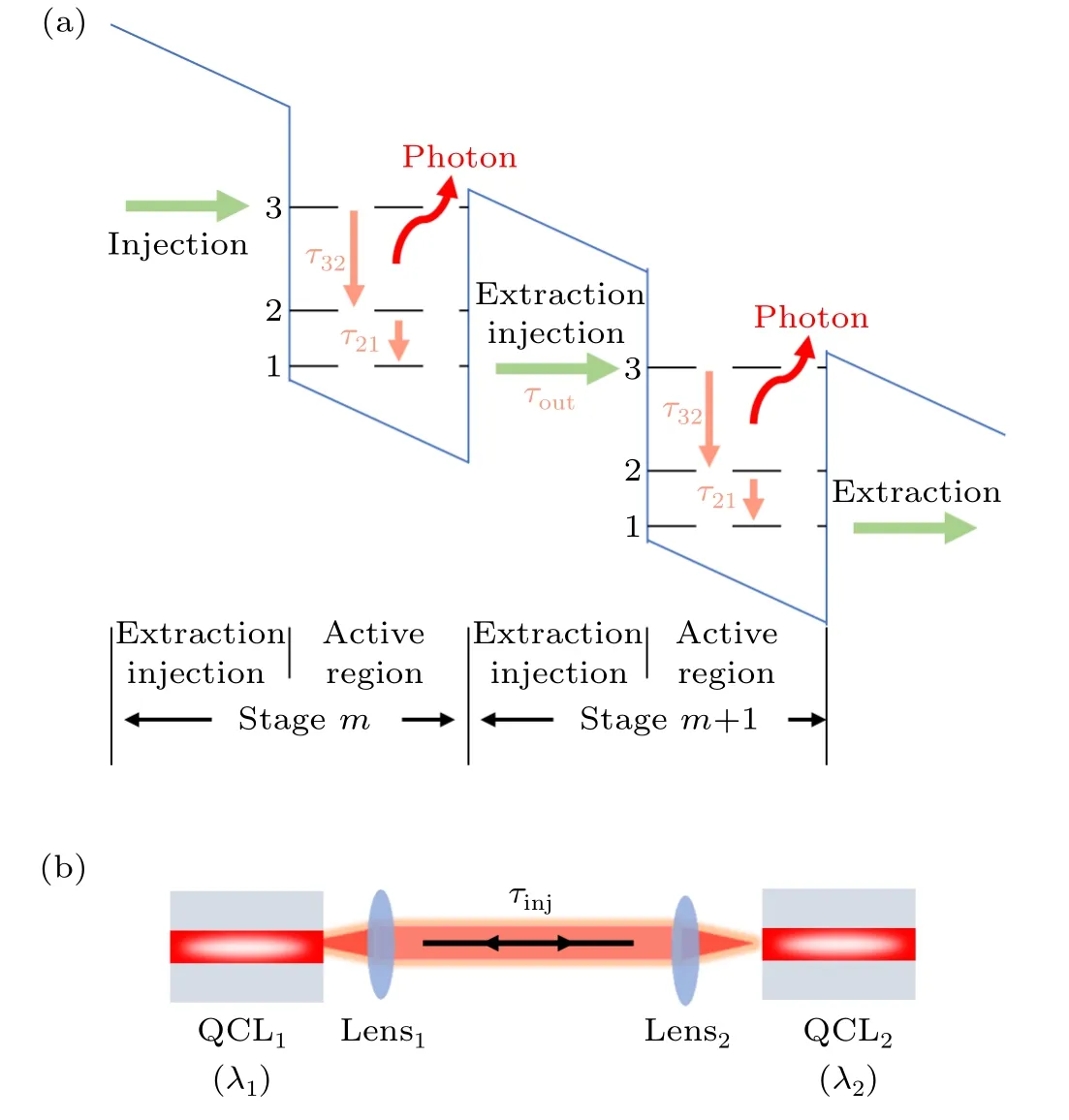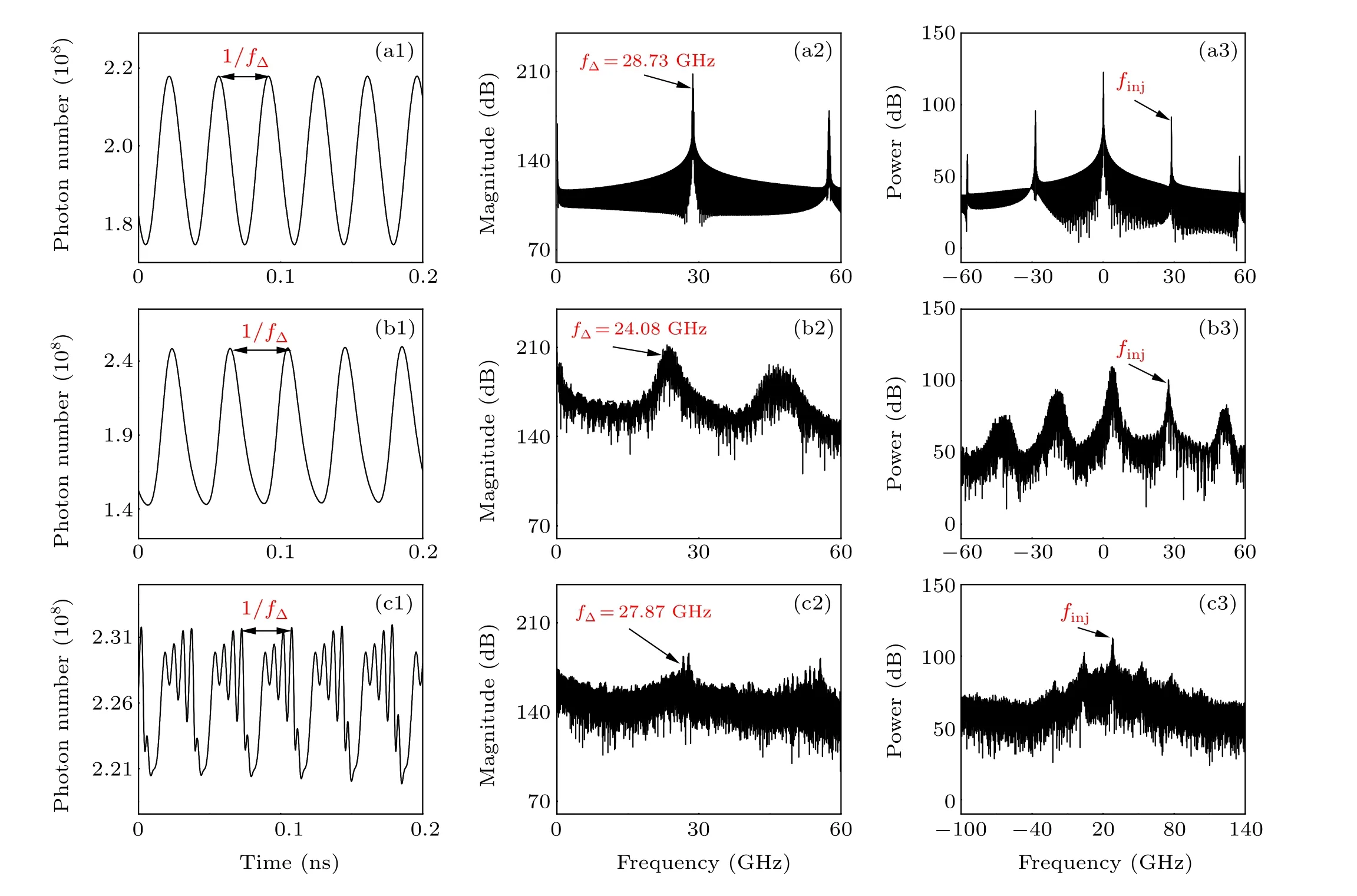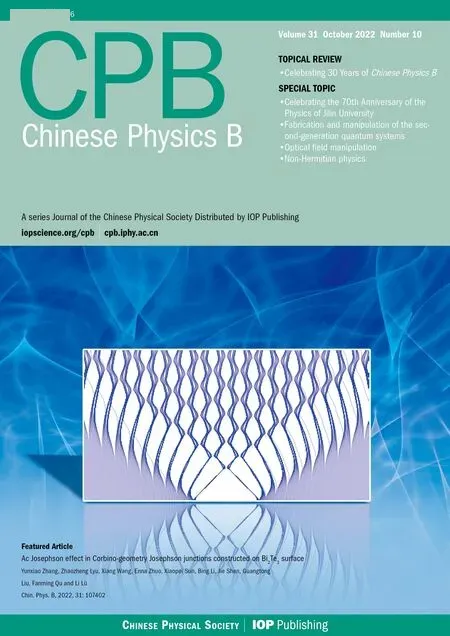Periodic and chaotic oscillations in mutual-coupled mid-infrared quantum cascade lasers
Zhi-Wei Jia(賈志偉) Li Li(李麗) Yi-Yan Guo(郭一巖) An-Bang Wang(王安幫) Hong Han(韓紅)Jin-Chuan Zhang(張錦川) Pu Li(李璞) Shen-Qiang Zhai(翟慎強) and Feng-Qi Liu(劉峰奇)
1Key Laboratory of Advanced Transducers and Intelligent Control System,Ministry of Education and Shanxi Province,College of Physics and Optoelectronics,Taiyuan University of Technology,Taiyuan 030024,China
2Key Laboratory of Semiconductor Materials Science,Beijing Key Laboratory of Low Dimensional Semiconductor Materials and Devices,Institute of Semiconductors,Chinese Academy of Sciences,Beijing 100083,China
Keywords: periodic oscillations,chaotic oscillations,mutual-coupled quantum cascade lasers
1. Introduction
Quantum cascade lasers(QCLs)are very promising midinfrared semiconductor lasers, which have been proven to be powerful and versatile.[1,2]By elaborately designing the structure of the active zone superlattice, the wavelength of QCLs can be tailored to cover the whole mid-infrared region.[3–5]Because of the lower transmission loss and higher scattering tolerance in the mid-infrared atmospheric windows bands(3 μm–5 μm and 8 μm–14 μm)compared to the well-developed nearinfrared bands, QCLs can find applications in diverse fields,such as free space communications,[6–8]laser ranging,[9]remote sensing,[10,11]and optoelectronic countermeasure.[12]
In the practical use, the stability of QCLs subject to inevitable external optical perturbation is very important,while the dynamic behaviors of QCLs have not been well understood. External optical perturbation can drive near-infrared semiconductor lasers, which are based on inter-band transition, from stable state to various dynamic states, including periodic oscillation,[13,14]chaotic laser state,[15,16]lowfrequency fluctuations,[17–19]regular pulse packages,[20]etc.Unlike inter-band semiconductor lasers, QCLs are based on the inter-subband electron transition,[1]with ultrafast carrier dynamics[21]and theoretically near-zero linewidth enhancement factor(α-factor).[22]As a result,QCLs seem to be more stable to external optical perturbation.[23]However, dynamic states of QCLs are often observed in applications and researches. In 2016, Grillotet al. reported the experimental observation of low-frequency chaotic laser in a distributed feedback (DFB) QCL with external optical feedback.[24]Recently, Wanget al. observed low-frequency oscillations in QCLs with tilted optical feedback.[25,26]There are also some theoretical models, based on rate equations or Maxwell–Bloch equations,demonstrating periodic oscillations,[27]selfpulsations,[28]low-frequency fluctuations,[24]even wide-band chaotic laser in QCLs.[29]But these works are not enough to understand the dynamic behaviors of QCLs. Experimental observation of high-frequency dynamic oscillations is still lacking,apart from the active modulation and self-pulsations. The wide-band chaotic laser predicted by Ref. [29] cannot be observed even the feedback strength is higher than 60% in our experiment.
The high-frequency periodic oscillation in inter-band semiconductor lasers is always related to the relaxation oscillation dynamic, and the wide-band chaotic laser state is usually resulted from the interaction of the external periodic dynamic and the relaxation oscillation dynamic. But the relaxation oscillation is absent in QCLs because of the ultrafast carrier dynamics.[30]We can deduce that the high-frequency oscillation in QCLs should be related to a high-frequency dynamic,such as optical modes beating.
In this work, we numerically investigated the dynamic states in mutual-coupled mid-infrared QCLs based on the Lang–Kobayashi equations. The two QCLs had different optical frequencies to bring in optical modes beating dynamic.The external-cavity length between the two QCLs wasL=1.5 m, corresponding to the injection time delayτinj=L/c.When the injection strengthkinjwas as low as 0.1,three types of period-one states with different periods were found,which were injection time delayτinj, 2τinj, and reciprocal of the detuning frequency. The evolution of dynamic states at different frequency detuning Δfwas also studied askinjincreased.Several dynamic states were observed, including period-one,square-wave,quasi-period,pulse-burst and chaos.The physics mechanism of the dynamical evolution was discussed. It can be concluded that: (i) external-cavity dynamic and optical modes beating are the mainly periodic dynamics; (ii) strong injection can stimulate strong optical nonlinear and high-order harmonics dynamics to break the periodic oscillations;(iii)the complex pulse-burst and chaotic states are resulted from the interaction of the external-cavity periodic dynamic and optical modes beating and the stimulation of optical nonlinear.
2. Theoretical model
Figure 1 shows the schematic of the two-stage band structure of a typical mid-infrared QCLs active zone and the structure diagram of the mutual-coupled QCLs. As shown in Fig.1(a),each stage of the QCLs active zone is composed of an extraction/injection region and an active region. Electrons from the last stage are injected into the energy level 3 of the active region by the extraction/injection region. Then electrons in the energy level 3 transit to the energy level 2 with the timeτ32, meanwhile, photons are stimulated. Subsequently, electrons in the energy level 2 are scattered to the energy level 1 by longitudinal-optical phonons with the timeτ21. Afterwards electrons in the energy level 1 are extracted and injected into the next stage with the timeτout. Becauseτ21andτoutare shorter thanτ32, population inversion occurs between the energy level 3 and the energy level 2. Though electrons in the energy level 3 also transit to the energy level 1 with the timeτ31, population inversion does not occur between the energy level 3 and the energy level 1 because of the very shortτ21.Based on the band structure,the rate equations describing the number of carriers are as follows:



Fig.1. (a)Schematic of two-stage band structure of QCLs active zone. (b)Structure diagram of mutual-coupled QCLs.

whereφrepresents the phase of the optical field,mis the stage number in the active zone,βis the spontaneous emission factor,τspis the spontaneous emission time,kinjis the injection strength, which is defined by the ratio of the injected laser power and the intrinsic laser power,τLis the round-trip time inside the laser cavity,αis the linewidth enhancement factor of QCLs, which is smaller than that in traditional inter-band semiconductor lasers. The coupling phaseθ1,2is



Table 1. The used parameters for the simulation.
The rate Eqs.(1)–(5)are numerically solved by using the fourth-order Runge–Kutta method with time lag 0.1 ps. The obtainedS(t) is regarded as the time series of laser intensity.The electric field of laser can be described by

whereωis the angular frequency of QCL.The Fourier transforms ofS(t)andE(t)are used to describe the power spectra and optical spectra.
3. Results and discussion
3.1. Absence of the relaxation oscillation
Firstly,we solved the rate equations of free-running QCL and studied the response of the QCL by applying the step current, where the current was increased from low-level currentIthto a high-level current. Figure 2(a) shows the QCL responses with the high-level currents of 1.01Ithand 2Ith. As shown, the photon number monotonically increases from the low-level value to the high-level value. There is no relaxation oscillation occurring, which is similar to the existed viewpoint.[30]The response times, which are defined as the time of photon number increasing from 10% to 90%, are respectively 12.18 ps and 11.31 ps when the high-level currents are 1.01Ithand 2Ith. Figure 2(b) plots the response time as a function of the high-level current. As the high-level current increases, the response time decreases. This indicates that a high current can enhance fast dynamics in QCLs. Therefore,we chose the high pump current of 2Ith, with theαequal to 1.7,in the following work.

Fig.2. (a)QCL response with the high-level current of 1.01Ith and 2Ith. (b)The response time as a function of the high-level current.
3.2. Three types of period-one states
Secondly, we solved the rate equations of the mutualcoupled QCLs with fixed injection strengthkinj=0.1 and varying the detuning frequency Δf. The nonlinear dynamic states of the two QCLs are similar, therefore, we only show the results of QCL1in this paper.
Three types of period-one (P1) states with different periods are found. The time series, power spectra and optical spectra are plotted in Fig. 3. At Δf=0 GHz, as shown in Fig.3(a),sinusoid-like time series with the period of the injection time delayτinjis observed,with a fundamental frequency peak of 0.2 GHz and very low harmonic peaks in the power spectrum. In the optical spectrum,there are a cluster of peaks with the interval of 0.2 GHz. This is different from the P1 state of the inter-band semiconductor lasers,where the fundamental frequency is mainly determined by the relaxation oscillation. At Δf=1 GHz, as shown in Fig. 3(b), the period is equal to twice the injection time delay (2τinj), with a fundamental frequency peak of 0.1 GHz in the power spectrum.In the optical spectrum,the interval of peaks is also 0.1 GHz.At Δf=20 GHz, as shown in Fig. 3(c), the period is about 51.4 ps, the fundamental frequency peak in the power spectrum isfΔ~19.438 GHz,and the interval of peaks in the optical spectrum is alsofΔ.
In our model, Δf=0 GHz means that QCL1and QCL2are exactly identical. Therefore,the mutual-coupled structure is equivalent to self-injection with a time delay. The P1 state with the period ofτinjcan be identified as the dynamic oscillation from the external-cavity periodic dynamics,which is also observed in the vertical-cavity surface-emitting laser.[32]Actually, there will never be two identical QCLs. The situation at Δf=0 GHz will not be described in following. When Δf/=0 GHz and is small, complete injection locking is easily realized in the mutual-coupled QCLs. Complete injection locking means that the intrinsic resonant mode is suppressed.In this case,the laser mode is decided by the injected field,and one QCL is an optical modulation and feedback component for the other QCL.The P1 state with the period of 2τinjis corresponding to the gradual mode hopping,which is resulted from the external-cavity optical injection. In Fig. 3(b), two peaks with the interval of Δf=1 GHz can also be observed in the optical spectrum,while the peak of 1 GHz cannot be observed in the power spectrum. This indicates that the two modes do not exist simultaneously,which also proves the mode hopping.Due to the existence of a series of external-cavity modes, the time series is sinusoidal-like. When Δfincreases to 20 GHz,injection locking is not complete, i.e., the intrinsic resonant mode will not be suppressed by the optical injection. In this case,the intrinsic resonant mode and the laser mode from optical injection coexist in QCLs. As shown in Fig.3(c3),more than two peaks can be observed, which demonstrates that the relative phase between the two modes is locked by mutual injection. Therefore, the P1 state with the period offΔis induced by optical modes beating. The oscillation frequencyfΔis slightly smaller than Δf,which is the same as that in QCL with unidirectional optical injection.[27]Because the pulling effect in QCLs dominates over the red-shift effect,the injected mode pulls the resonant mode away from its free-running frequency towards the injected one.

Fig. 3. Three types of period-one states at detuning frequency (a) Δf =0 GHz, (b) Δ f =1 GHz, (c) Δ f =20 GHz, with fixed injection strength kinj =0.1. Column 1 shows time series, column 2 shows power spectra and column 3 shows optical spectra. The insets in(a3)and(b3)show the enlarged view around the peaks. The finj is the optical frequency of the laser mode resulted from optical injection.
3.3. Influence of injection strength at different detuning frequencies
Furtherly, we studied the evolution of dynamic states by increasing injection strengthkinjat the Δfof 2 GHz, 7 GHz,14 GHz,20 GHz,and 29 GHz,which corresponded to the five typical evolution routes.
Figure 4 depicts the time series, power spectra and optical spectra at Δf=2 GHz with differentkinj. Atkinj=0.1,as shown in Fig.4(a), the P1 state is similar to that in Fig.3(b).The time series shows a distorted sinusoidal waveform and hence high-order harmonic peaks arise in the power spectra.The distorted waveform is corresponding to the decreased injection locking when Δfincreases. Atkinj=0.45,as shown in Fig.4(b),the time series is a square wave(SW)with the period of 2τinjand duty cycle of about 40%. In the optical spectrum,the external-cavity modes are weakened,the intrinsic resonant mode and the injected laser mode become obvious. It can be explained by that the stronger injection enhances the stability of laser modes, to some extent, suppressing the externalcavity modes.As a result,the time series transfers into SW.Atkinj=0.58,QCLs exhibit quasi-periodic(QP)oscillation,with the consistent period with that of Figs.4(a)and 4(b). And the wavelength blueshift can be observed in the optical spectrum,with more external-cavity modes. This indicates that strong nonlinear optical action occurs and breaks the injection locking,leading to the QP oscillation.

Fig.4. Time series,power spectra and optical spectra at Δf =2 GHz for injection strength kinj of(a)0.1,(b)0.45,and(c)0.58.

Fig.5. Time series,power spectra and optical spectra at Δf =7 GHz for injection strength kinj of(a)0.01,(b)0.13,(c)0.25,and(d)0.35.

Fig.6. Time series,power spectra and optical spectra at Δf =14 GHz for injection strength kinj of(a)0.01,(b)0.3,(c)0.35,and(d)0.4. The inset in(b2)shows the enlarged view around the peaks.
Figure 5 shows the time series,power spectra and optical spectra at Δf=7 GHz with differentkinj. Atkinj=0.01, as shown in Fig. 5(a), the P1 state resulted from optical modes beating is observed. The time series has a sinusoidal waveform. There exists a sharp peak atfΔof 6.74 GHz and a small peak at external-cavity frequencyfECof 0.1 GHz in the power spectrum. The optical spectrum is similar to that in Fig.3(c3).Atkinj=0.13, the QCLs exhibit pulse burst (PB) state with stable amplitude and a burst period of 2τinj,and the pulses do not have evident periodicity. The power spectrum seems to indicate chaotic state with external-cavity periodic peaks. So the PB state can be thought as an intermittent chaotic state. In the optical spectrum, a wide envelope peak with a sharp central peak can be observed. The envelope peak and sharp peak correspond to the stable parts and the PB parts, respectively.Askinjincreases,the number of pulses in one burst decreases.Atkinj=0.25,QCLs exhibit SW state with the period of 2τinjand duty cycle of 30%. Atkinj=0.35,QCLs exhibit QP state.The SW and QP states are similar to those at Δf=2 GHz.
Figure 6 shows the time series,power spectra and optical spectra at Δf=14 GHz with differentkinj. Atkinj=0.01,as shown in Fig. 6(a), the P1 state resulted from optical modes beating with the sinusoidal time series is observed. There are only sharp peaks at integer multiplefΔin the power spectrum.The external-cavity periodic dynamic is completely suppressed. The optical spectrum is similar to that in Fig.3(c3).Atkinj=0.3,both the optical modes beating periodic dynamic and the external-cavity periodic dynamic become evident in the time series and power spectrum. Here we choose a critical periodicity suppression ratio of 20 dB.If the optical modes beating peak is 20 dB higher than the external-cavity periodic peak in the power spectrum,the dynamic state can be thought as P1 state. Otherwise, it is QP state, which is different from the QP state in Figs. 4(c) and 5(d). In the optical spectrum,thefΔis 12.01 GHz. Atkinj=0.35,the QCLs exhibit a weak chaotic state, with evident envelope peaks in the power and optical spectra. ThefΔis 6.82 GHz. Atkinj=0.4, the QCLs exhibit a strong chaotic state,with a wide-band and flat power spectrum and a very wide envelope optical spectrum. In the optical spectrum,only one envelope peak can be observed.
Figure 7 shows the time series, power spectra and optical spectra at Δf= 20 GHz with differentkinj. Atkinj=0.01, the QCLs exhibit the similar P1 state to that shown in Fig.6(a). The external-cavity periodic dynamic is completely suppressed. Atkinj=0.39, the QCLs exhibit the similar QP state to that shown in Fig.6(b). In the optical spectrum,thefΔis 16.79 GHz. Atkinj=0.55,the QCLs exhibit a chaotic state with a wide-band and flat power spectrum and a very wide envelope optical spectrum.But the chaotic state is different from that in Fig. 6(d). There is a very wide envelope peak around 20 GHz in the power spectrum. In the optical spectrum,there are two envelope peaks with the interval of 20.98 GHz.
We think that the two chaotic states in the mutual-coupled QCLs have different physical origins. When Δfis small, the pulling effect under strong injection can make the intrinsic resonant mode and injected mode very close, leading to strong interaction of the external-cavity periodic dynamic and optical modes beating. As a result, chaotic oscillation occurs. In the optical spectrum, there is only one wide envelope peak.When Δfis large, the pulling effect will be disabled askinjincreases,because of the strong optical nonlinear. Though the interaction of the external-cavity periodic dynamic and optical modes beating is weakened, the strong optical nonlinear can also break the periodic oscillation, leading to the chaotic oscillation. In the optical spectrum, there are two envelope peaks with the interval of Δf.

Fig.7. Time series,power spectra and optical spectrum at Δf =20 GHz for injection strength kinj of(a)0.01,(b)0.39,and(c)0.55. The inset in(b2)shows the enlarged view around the peaks.

Fig.8. Time series,power spectra and optical spectrum at Δf =29 GHz for injection strength kinj of(a)0.1,(b)0.57 and(c)0.59.
Figure 8 shows the time series,power spectra and optical spectra at Δf=29 GHz with differentkinj. Atkinj=0.1, the QCLs exhibit the P1 state resulted from optical modes beating,with very sharp peaks at integer multiplefΔin the power spectrum. A small peak atfECcan also be observed. Askinjincreases, the peaks at integer multiplefΔare gradually broadened and the peaks at integer multiplefECare gradually heightened. Atkinj=0.57,the peak atfΔ=24.08 GHz is still 24 dB higher than that atfEC=0.1 GHz. The dynamic state is P1 state. Atkinj=0.59,QCLs exhibit QP state with the period of 1/fΔ. In the time range of one period,higher-frequency oscillation can be observed. In the power spectra,apart from the peaks at integer multiples offΔ, there are also some peaks at the frequencies higher than 40 GHz. In the optical spectrum,narrow peaks can be observed.
3.4. Mapping of dynamic states
In order to furtherly understand the dynamic behaviors in QCLs, the mapping of dynamic states in the parameter space of Δfandkinjis presented in Fig. 9(a). In the figure, different dynamic states are shown by different colors. The blue zones represent the P1 state. Two P1 zones can be observed:the lower left one is the P1 resulted from the external-cavity periodic dynamic, the lower right one is the P1 resulted from optical modes beating. The light-blue zone represents the SW state. The SW state zone is only observed in the range of detuning frequency lower than 10 GHz, where complete injection locking can be achieved. The green zone represents the QP state. The QP state zone actually consists of three parts: external-cavity QP state zone (examples in Figs. 4(c)and 5(d)), optical modes beating QP state zone (example in Fig. 8(c)), and the bioscillation QP state zone (examples in Figs. 6(b) and 7(b)). The light-green zones represent the PB state. The PB state zones are multiple discrete small zones,which are distributed in the QP state zone,where strong interaction of the external-cavity periodic dynamic and the optical modes beating periodic dynamic occurs. The white zone represents the chaotic(C)state.
Figure 9(b)shows the chaos bandwidth in the parameter space, which is given by the red dash line box in Fig. 9(a).Two types of chaotic states are given the names of chaos and chaos(Δf),which are distinguished by whether there is a wide envelope peak at Δf. The black dash line is the boundary between chaos and chaos(Δf). In the chaos zone,the bandwidth is always around 14 GHz. In the chaos(Δf) zone, the bandwidth increases gradually with the increase of Δf, showing the way to generate mid-infrared wide-band chaotic laser in mutual-coupled QCLs.

Fig.9. (a)Mapping of dynamical states in the parameter space of detuning frequency Δ f and injection strength kinj. P1: period-one;SW:square wave;QP:quasi period; PB:pulse burst; C:chaos. The orange dashed line from left to right represents the detuning frequencies of 2 GHz,7 GHz, 14 GHz, 20 GHz,and 29 GHz respectively. (b)Bandwidth of chaotic state in parameter space of Δf and kinj,given by the red dash line box in(a).
4. Conclusion
We numerically investigated the dynamic states in mutual-coupled mid-infrared QCLs and discussed the physical mechanism of dynamic states evolution. Three types of P1 states with different periods were found, which wereτinj,2τinj, and reciprocal of the detuning frequency. There was no relaxation oscillation observed. By changing the injection strength and detuning frequency,several other dynamic states were demonstrated, including SW, QP, PB, and chaotic laser.The external-cavity periodic dynamics and optical modes beating are the mainly periodic dynamics. High-order harmonics dynamics and strong optical nonlinear can be stimulated by strong injection. When Δfis small or very large,the interaction of the two periodic dynamics is very weak. Strong injection can drive the P1 state to SW and QP states. When Δfis in the proper range,strong interaction of the two periodic dynamics occurs,leading to PB state and chaotic state. The PB state can be thought as an intermittent chaotic state. Strong injection can make the chaotic state more stable. This work helps to understand the physics mechanism of dynamic behaviors in QCLs and open a new way to mid-infrared wide-band chaotic laser.
Acknowledgments
Project supported by the National Key Research and Development Program of China(Grant No.2019YFB1803500),the National Natural Science Foundation of China (Grant No. 61805168), the Natural Science Foundation of Shanxi Province, China (Grant Nos. 201801D221183 and 20210302123185), International Cooperation of Key Research and Development Program of Shanxi Province (Grant No.201903D421012),Research Project Supported by Shanxi Scholarship Council of China(Grant No.2021-032),Scientific and Technological Innovation Programs of Higher Education Institutions in Shanxi (Grant No. 2019L0133), and Fund for Shanxi“1331 Project”Key Innovative Research Team.
- Chinese Physics B的其它文章
- Formation of high-density cold molecules via electromagnetic trap
- Dynamics of molecular alignment steered by a few-cycle terahertz laser pulse
- Terahertz spectroscopy and lattice vibrational analysis of pararealgar and orpiment
- Molecule opacity study on low-lying states of CS
- Finite-time Mittag–Leffler synchronization of fractional-order complex-valued memristive neural networks with time delay
- Ultrafast Coulomb explosion imaging of molecules and molecular clusters

